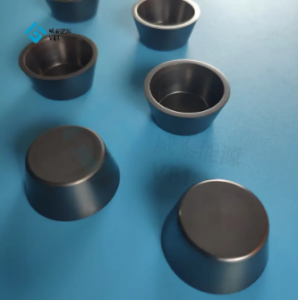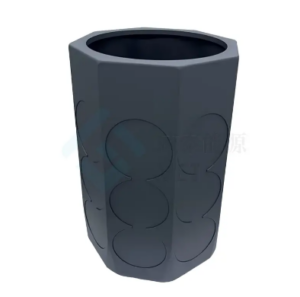
Silicon carbide (SiC) coating plays a pivotal role in semiconductor processing by enhancing the performance of manufacturing equipment. Its application on graphite surfaces, known as SiC coating on graphite, ensures durability and resistance to wear. Industries rely on SiC coatings for processes like MOCVD, epitaxial growth, and thin film deposition. These coatings excel in high-temperature environments, such as oxidation and diffusion processes, where they protect components from contamination. Additionally, they outperform alternatives like TaC coating in thermal stability and purity, making them indispensable in semiconductor crystal growth and high-vacuum applications.
Key Takeaways
- SiC coatings make semiconductor tools last longer and work better. They stop damage and keep tools clean.
- These coatings work well in high heat, staying strong and spreading heat efficiently.
- Adding SiC coatings to processes like epitaxy and CVD improves results. It reduces defects and keeps wafers clean for better quality.
Overview of SiC Coating
Unique properties of SiC coatings
Silicon carbide (SiC) coatings exhibit a range of unique chemical and physical properties that make them highly effective in demanding applications. These coatings are typically produced with a β 3C (cubic) crystal structure, which provides excellent corrosion resistance. Their density of 3200 kg/m³ and 0% porosity ensure helium leak-tight performance, making them ideal for high-purity environments.
| Property | Description |
|---|---|
| Crystal Structure | β 3C (cubic) crystal structure, offering optimal corrosion protection. |
| Density and Porosity | High density and 0% porosity, ensuring durability and leak-tight performance. |
| Thermal Conductivity | 200 W/m·K, enabling superior heat management. |
| Electrical Resistivity | 1MΩ·m, suitable for electrical insulation. |
| Mechanical Strength | Elastic modulus of 450 GPa, providing exceptional structural integrity. |
In addition to these properties, SiC coatings are chemically inert, resisting corrosion even in harsh environments. Their mechanical strength and fracture toughness prevent damage under stress, while their high thermal conductivity ensures efficient heat dissipation. These characteristics make SiC coatings indispensable in high-temperature and high-stress applications.
Role in semiconductor manufacturing equipment
SiC coatings play a critical role in enhancing the performance and longevity of semiconductor manufacturing equipment. They protect components involved in processes like crystal growth, epitaxy, and oxidation by preventing contamination and resisting wear. Their thermal stability ensures consistent performance in high-temperature environments, while their chemical inertness safeguards against corrosion.
- Semiconductor Crystal Growth: SiC coatings protect tools from corrosion and thermal damage, ensuring the purity of silicon and other crystals.
- Epitaxy Processes: They prevent oxidation and contamination, maintaining the quality of epitaxial layers.
- Oxidation and Diffusion: SiC coatings act as barriers against impurities, improving the integrity of the final product.
By enhancing durability and reducing contamination risks, SiC coatings improve the efficiency and reliability of semiconductor manufacturing equipment. This results in higher yields and better product quality, making them a cornerstone of modern semiconductor processing.
Applications of SiC Coating in Semiconductor Processing
Use in epitaxy and CVD processes
SiC coatings play a vital role in epitaxy and chemical vapor deposition (CVD) processes. These coatings are widely used in the epitaxial growth of silicon and silicon carbide (SiC), where they prevent oxidation and contamination. This ensures the production of high-quality epitaxial layers, which are essential for manufacturing high-performance semiconductor devices.
During epitaxy, SiC coatings on graphite susceptors protect against reactions with atomic hydrogen. This protection is critical in processes like the reaction NH3 + TMGa → GaN + byproducts, which occurs at elevated temperatures. Additionally, SiC coatings enhance thermal management by maintaining consistent temperatures, which is crucial for achieving defect-free and uniform layers in LEDs and silicon wafers. Their ultra-pure composition, with a purity level of 99.99995%, minimizes contamination risks, further improving process efficiency and yield.
Role in oxidation and diffusion processes
In oxidation and diffusion processes, SiC coatings act as effective barriers against impurities. This protective layer enhances the integrity of the final semiconductor product. High-purity sintered SiC tubes and wafer boats, often coated with SiC, are essential for handling wafers and maintaining purity during these high-temperature steps.
SiC coatings also improve the longevity and reliability of components exposed to extreme conditions. For instance, SiC lining walls in tube furnace equipment enhance performance by resisting wear and contamination. These features make SiC coatings indispensable for ensuring the quality and durability of semiconductor manufacturing tools.
Performance in high-temperature environments
SiC coatings excel in high-temperature environments due to their exceptional thermal stability and mechanical strength. They can withstand temperatures up to 1600°C at atmospheric pressure, making them suitable for demanding applications. Their high thermal conductivity, measured at 200 W/m·K, ensures efficient heat dissipation, while their oxidation resistance maintains component integrity under extreme conditions.
These coatings also resist contamination, providing a barrier against impurities that could compromise the performance of semiconductor devices. Their durability and structural stability across a wide temperature range make them a cost-effective solution for industries requiring high-purity and reliable materials.
Benefits of SiC Coating
Enhanced durability and wear resistance
SiC coatings significantly improve the durability and wear resistance of semiconductor manufacturing equipment. These coatings extend the lifespan of components by protecting them from mechanical stress and surface degradation. Their high thermal conductivity ensures consistent performance during high-temperature processes, reducing the likelihood of equipment failure.
- SiC coatings exhibit superior mechanical strength, with an elastic modulus of 450 GPa, outperforming many alternative materials.
- Their chemical inertness minimizes contamination risks, maintaining wafer purity and enhancing device reliability.
- The coatings resist oxidation and degradation, even in extreme conditions, ensuring long-term functionality.
These properties make SiC coatings an ideal choice for industries requiring robust and reliable materials.
Thermal stability and oxidation resistance
SiC coatings excel in providing thermal stability and oxidation resistance, which are critical for semiconductor processing. Their β 3C (cubic) crystal structure offers optimal corrosion protection, while their density of 3200 kg/m³ and 0% porosity ensure effective resistance to environmental damage.
| Property | Description |
|---|---|
| Crystal Structure | β 3C (cubic) crystal structure, providing optimal corrosion protection. |
| Density and Porosity | High density and 0% porosity, ensuring effective corrosion resistance. |
| Thermal Conductivity | 200 W/m·K, enabling superior heat management. |
| Mechanical Strength | Elastic modulus of 450 GPa, enhancing structural integrity. |
These features allow SiC coatings to withstand temperatures up to 1600°C, making them suitable for high-temperature applications. Their ability to resist oxidation ensures the integrity of components, even under extreme conditions.
Efficiency improvements in semiconductor manufacturing
SiC coatings enhance the efficiency of semiconductor manufacturing by improving equipment performance and reducing contamination risks. Their high thermal conductivity ensures uniform heat distribution, which is essential for processes like epitaxy and chemical vapor deposition. This uniformity minimizes defects in semiconductor layers, leading to higher yields and better product quality.
The coatings also reduce maintenance requirements by protecting equipment from wear and corrosion. This durability translates to fewer replacements and lower operational costs. By maintaining wafer purity and ensuring consistent performance, SiC coatings contribute to the overall efficiency and reliability of semiconductor manufacturing processes.
SiC Coating Collector Tops revolutionize semiconductor processing by improving layer quality, enhancing thermal management, and reducing contamination risks. These coatings protect components during epitaxial growth and oxidation processes, ensuring durability and efficiency. Future advancements, like nanotechnology and thermal spraying, promise even greater performance, driving innovation in semiconductor manufacturing and enabling higher yields with superior product quality.







